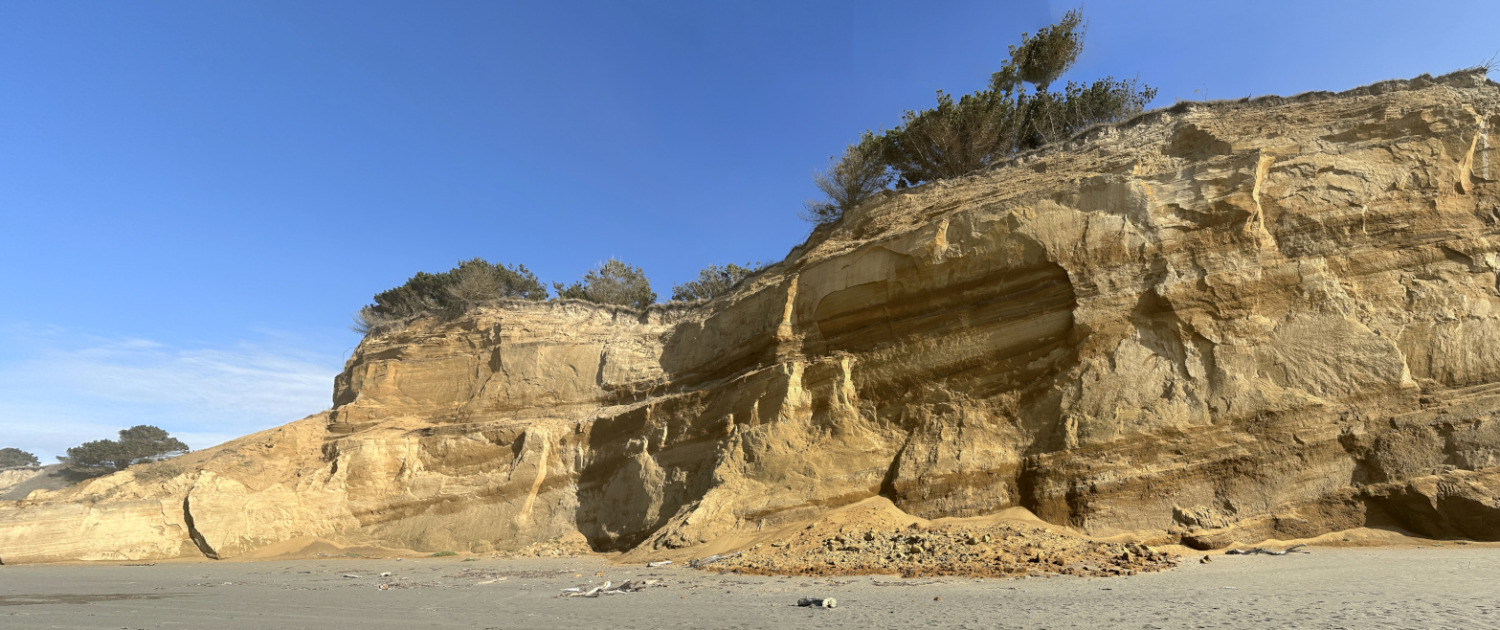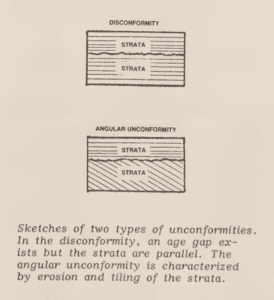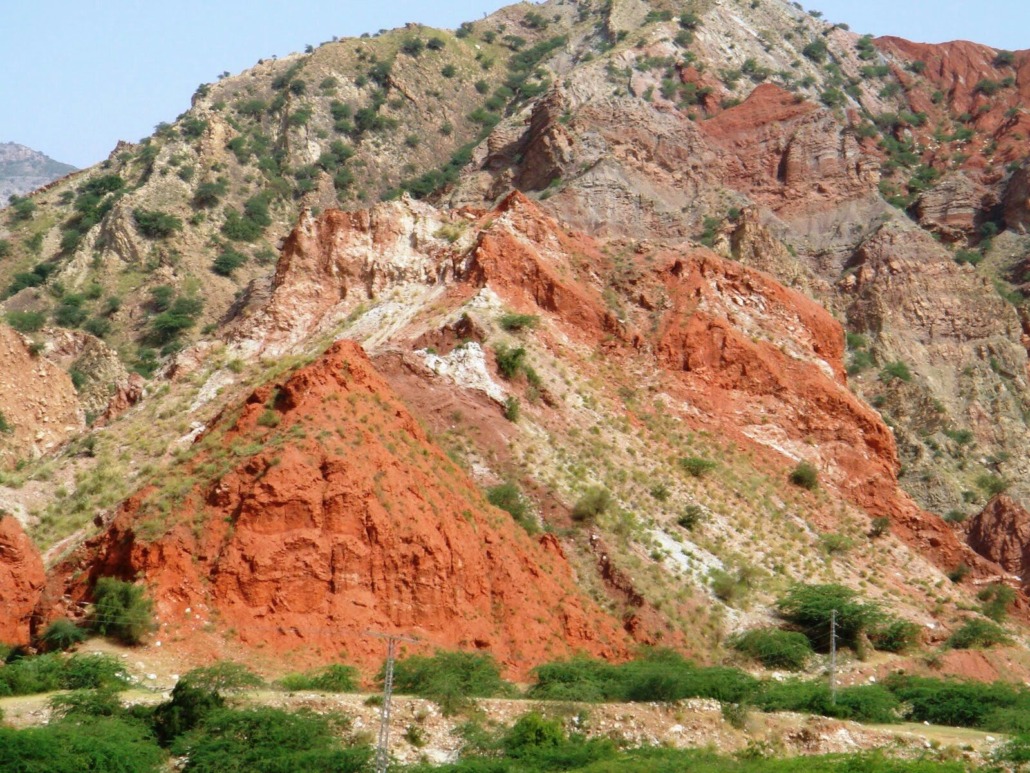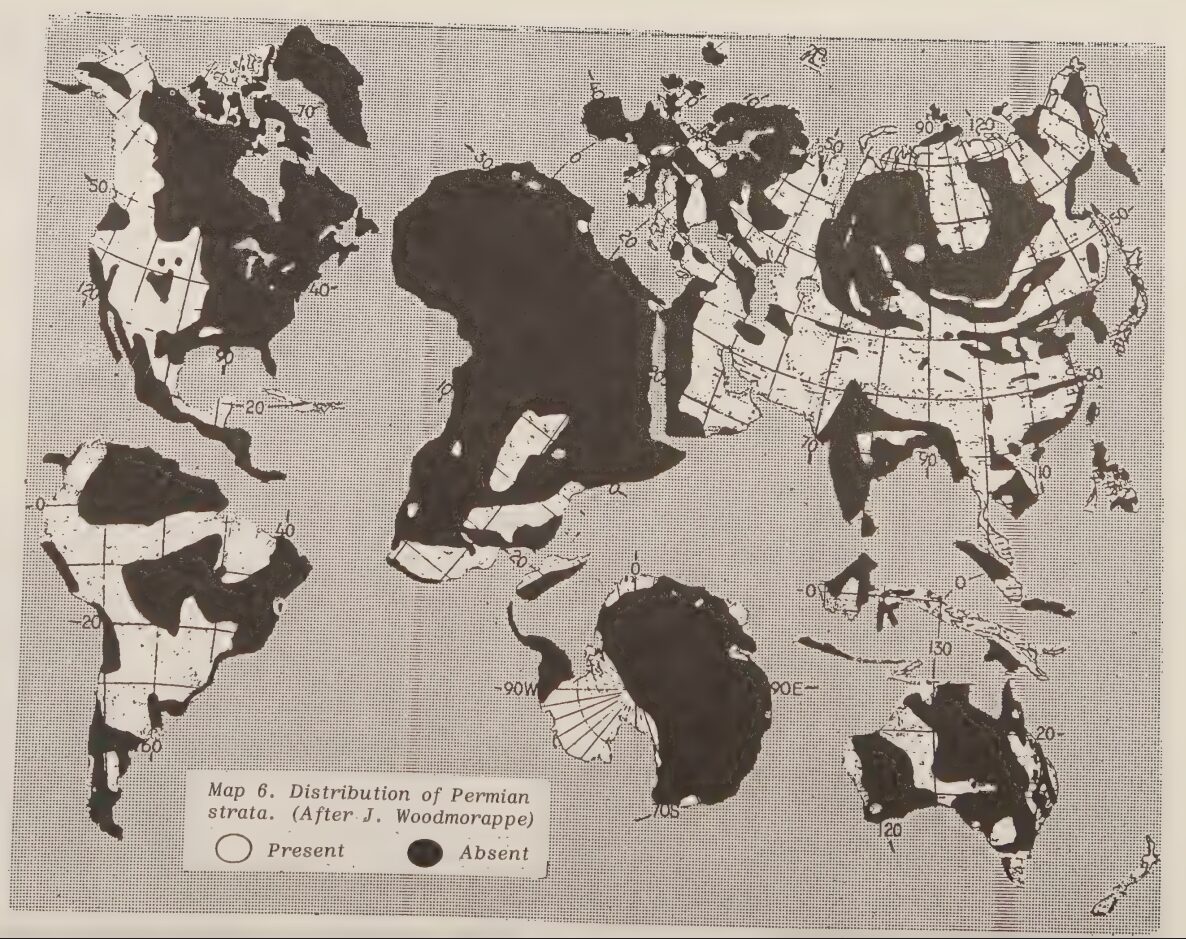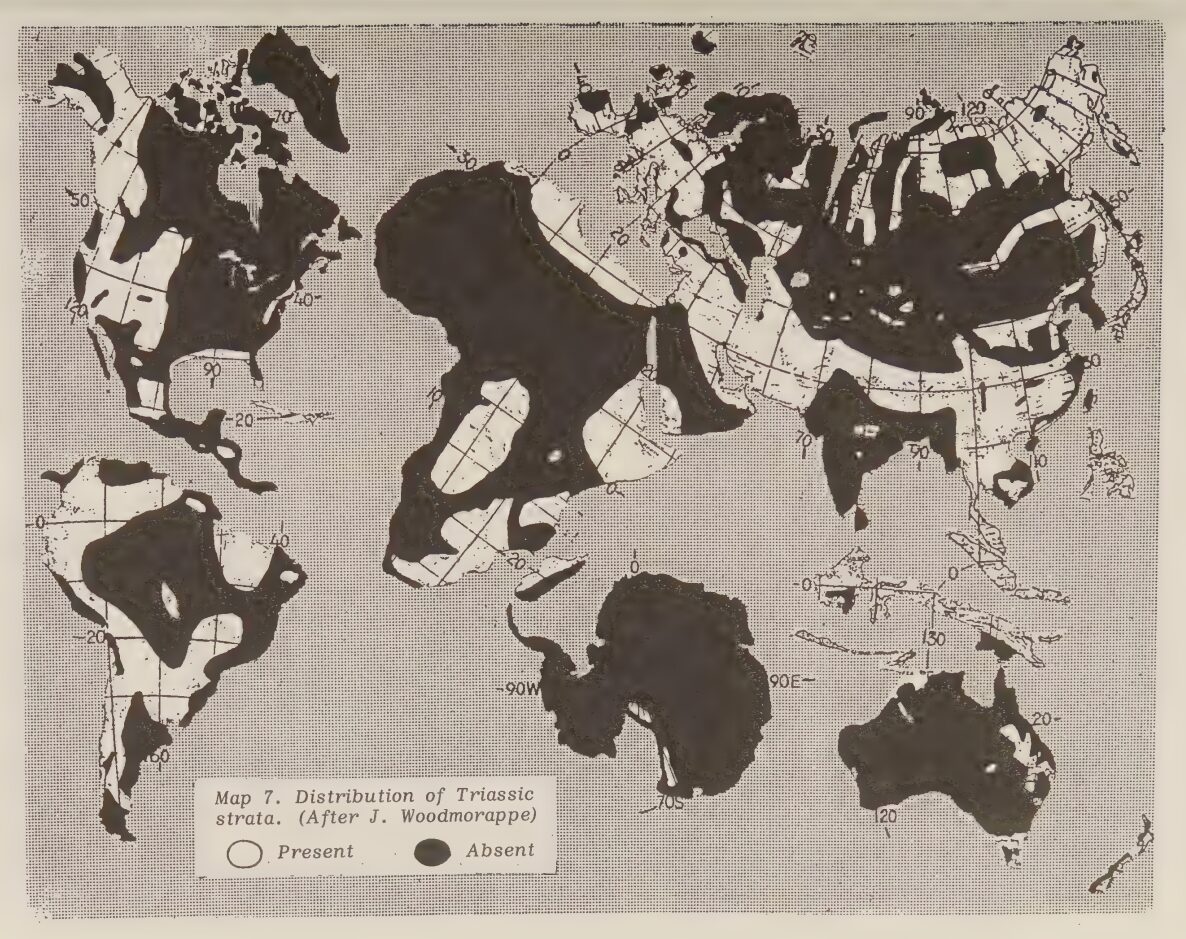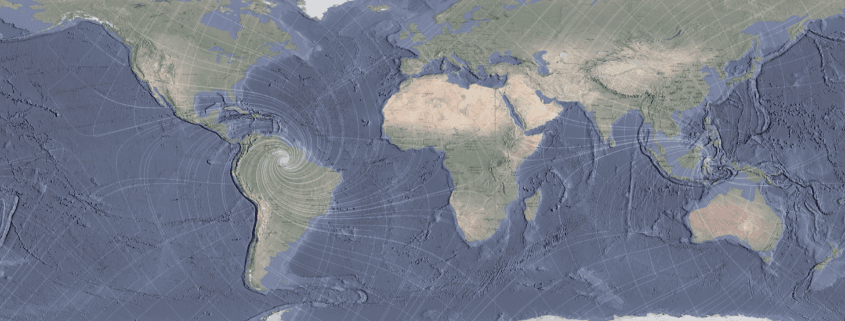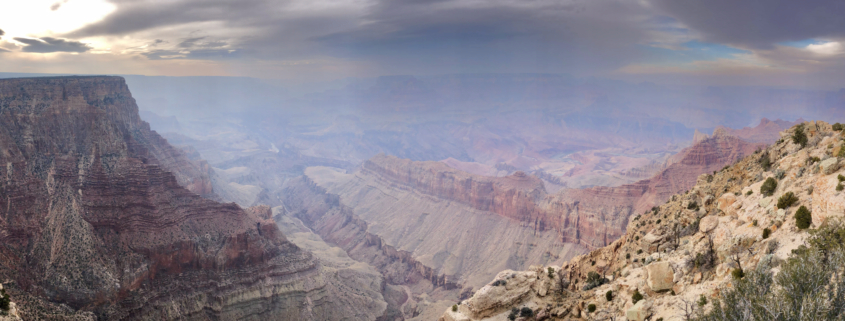Although the geological literature is forthcoming with many reports of unconformities, very few papers mention the remarkable incompleteness of the Stratigraphic Record. On the other hand, creationists have been verbose about gaps in the Stratigraphic Record; they have also produced the only systematic survey of stratigraphic gaps (based upon the scientific literature) that we have found to date.
A few small gaps here and there in the Stratigraphic Record could easily be explained away as due to erosion and/or cessations in deposition. However, the apparent gaps are so great in terms of time-span, volume, and geographical area, that an important anomaly may exist here. Some questions posed by these great gaps are:
- Is the accepted radiometric time scale accurate?
- Is the succession of geological periods, as determined by fossil content and the theory of evolution, really correct?
- Equivalently, is the development of terrestrial life envisaged by the theory of evolution correct?
- Are the geological periods (established by fossil content) actually synchronous over the entire globe?
These are among the most important questions we can ask of our science; therefore, the “gap” phenomenon is potentially very anomalous. Possible explanations include:
- Radiometric time measurements, for reasons we do not yet understand, are grossly in error. Consequently, the geologists’ time scale is in error.
- The succession of life forms presented by the theory of evolution is incorrect; and the geological periods are incorrectly assigned.
- The fauna that determine the geological periods have existed in times and places in ways that invalidate the concept of geological periods determined by evolution.
- Admittedly, the most likely explanation, based upon what we know today, is that gaps in straitigraphy are due only to episodes of erosion and/or hiatuses in deposition.
Introduction and Background. A “missing” sedimentary stratum in the Stratigraphic Record exists:
- Where adjacent strata possess fossil contents that differ appreciably, indicating the passage of a large amount of time, as measured by the evolutionary time scale. Generally, this means that we are restricted to saying that some geological period, such as the Ordovician, is missing. Geological periods have historically been defined and assigned on a time scale according to their fossil contents.
- Where adjacent strata possess appreciably different ages, as determined by radiometric dating. Radiometric dating, of course, is the technique geologists use to attach time markers on the Stratigraphic Record.
In this section, almost all missing strata are identified by the first method. The word “appreciable” is used above because our purpose here is to find large time gaps in the Stratigraphic Record. Obviously, the hiatus represented by the separation of annual varves in a clay deposit indicates only the cessation of deposition for a few months. This is hardly anomalous. We are searching for gaps measured in the millions of years. The existence of an apparent gap in the Stratigraphic Record – and therefore the apparent passage of considerable time – can be accounted for in several ways:
- Deposition of sediment ceased for a long period of time, perhaps because the geographical region under scrutiny rose above sea level, the climate changed drastically, or some other major terrestrial event occurred.
- The sediments deposited during the supposed “time gap” were somehow eroded away without a trace.
- The fossil contents of the strata are not accurate indicators of the passage of time. A possible implication here is that biological
development did not occur as currently envisaged. - Radiometric dating is faulty.
- Conceivably, thrust faulting interposed exotic strata between the properly sequenced strata. Stratigraphic Record would thus be tainted timewise.
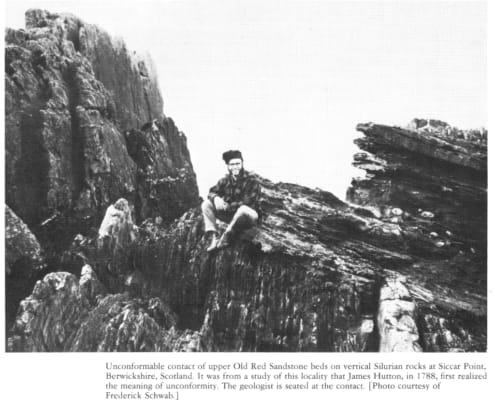 Unconformities and Their Significance. The nature of the contact between the strata on either side of a supposed missing stratum (or time gap) is important. If this contact is rough and/or non-parallel, we can usually conclude that geological forces, such as erosion, uplifting, and tilting, have been at work. The passage of time is also implied. Geologists apply the term “unconformity” to such situations. The two types of unconformities mentioned above are sketched in the accompanying illustration, and are designated as “disconformities” and “angular unconformities”. A more-difficult-to-explain unconformity is the “paraconformity”, in which there is no evidence of erosion, earthquakes, tilting of strata, or any other kind of time hiatus. At paraconformities, hundreds of millions of years seem to be missing without any attendant geological activity. This is anomalous indeed on the earth, which must be considered a very active planet.
Unconformities and Their Significance. The nature of the contact between the strata on either side of a supposed missing stratum (or time gap) is important. If this contact is rough and/or non-parallel, we can usually conclude that geological forces, such as erosion, uplifting, and tilting, have been at work. The passage of time is also implied. Geologists apply the term “unconformity” to such situations. The two types of unconformities mentioned above are sketched in the accompanying illustration, and are designated as “disconformities” and “angular unconformities”. A more-difficult-to-explain unconformity is the “paraconformity”, in which there is no evidence of erosion, earthquakes, tilting of strata, or any other kind of time hiatus. At paraconformities, hundreds of millions of years seem to be missing without any attendant geological activity. This is anomalous indeed on the earth, which must be considered a very active planet.
The Nature of the Stratigraphic Record:
“The sedimentary pile at any one place on the earth’s surface is nothing more than a tiny and fragmentary record of vast periods of earth history. This may be called the Phenomenon of the Gap Being More Important than the Record.” (R12)
The implications depend upon the theory being defended. Some students of the Stratigraphic Record view missing strata as proof that uniformitarianism is an incorrect picture of the earth’s past. To illustrate the catastrophists’ position, we quote from A.W. Mehlert, who in turn draws from H.H. Howorth, a proponent of universal flooding.
“The next virtually fatal problem for uniformitarian geology is the presence of thousands of cases of deceptive conformities (paraconformities) in the understrata involving both continental and marine deposits. These cases, some of them covering vast areas occur when two deposits, allegedly separated by many millions of years, lie smoothly together with not the slightest sign of erosion on the lower beds. I will let Sir Henry Howorth, a non-creationist geologist of 80 years ago, eloquently describe his thoughts on paraconformaties in his 1905 work Ice or Water?
The absence of the erosive agency of water, as manifested in cutting valleys and gorges in the under strata of the earth, is fatal to the theory that each formation has successively emerged from the sea and become the surface of the habitable world… What we want to see is a plain instance of valleys excavated and mountains formed in the ancient strata of the earth as we find them existing in the present day… until then we take leave to reject the theory… the parallelisms of the beds over large regions of the earth stand in complete opposition (to the notion that the under strata have ever been the surface of the earth for indefinite periods.)” (R20)
Modern geologists, however, consider missing strata as only a minor inconvenience. A.N. Strahler, after discussing the two giant gaps in the Grand Canyon’s sequence of strata, commented:
“Although this long interval of freedom from tectonic activity is remarkable, it poses no special problem to mainstream geology.” (R23)
In the following entries, we shall see that the “problems” are not entirely negligible, particularly in the Grand Canyon. (X4) Finally, in the interest of completeness we should not set aside the possibility, remote though it may seem, that missing strata might indicate basic flaws in geochronology and/or the way in which we believe life of earth developed.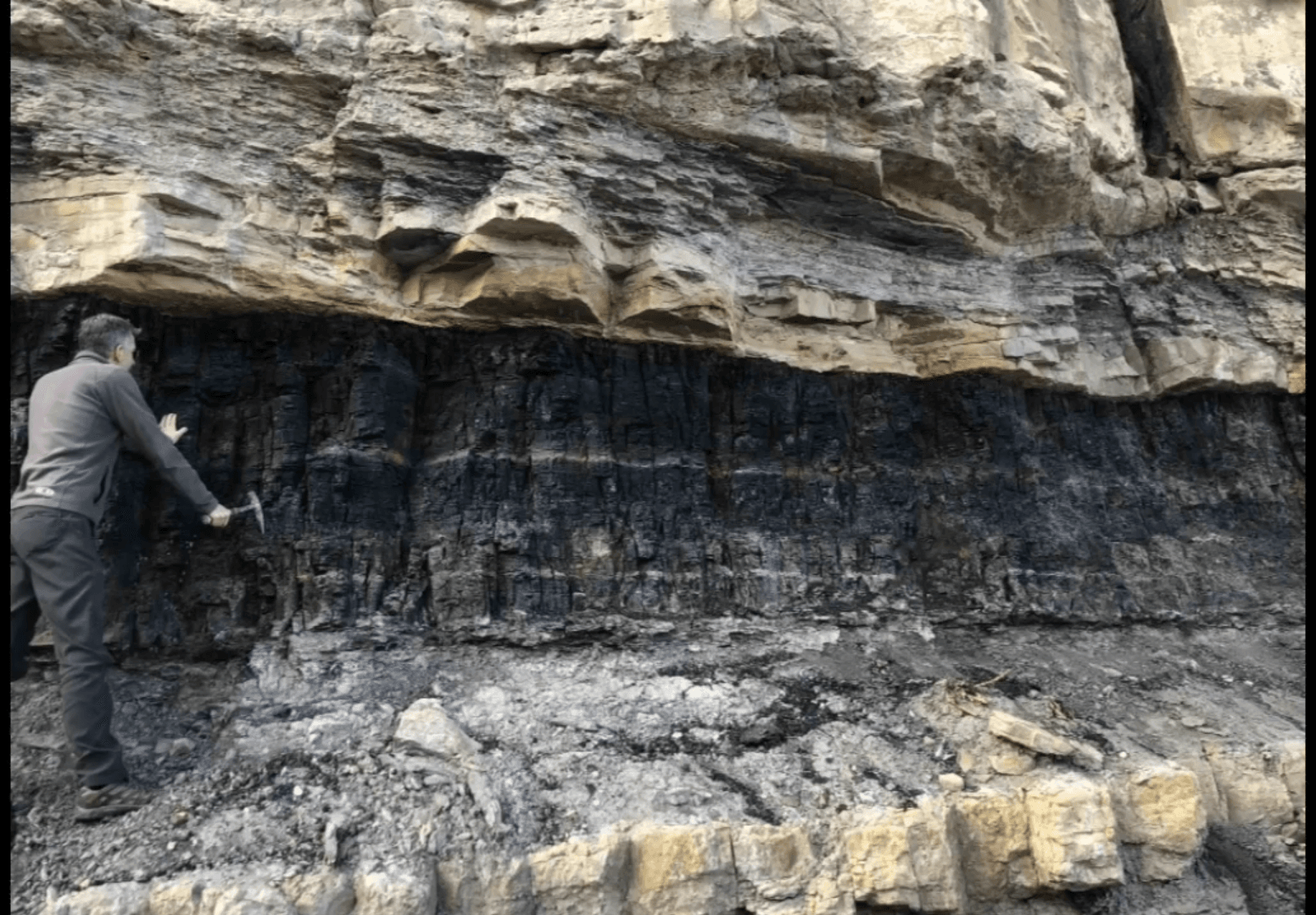
Missing Precambrian crust and ophiolites. The oldest rocks are those of the Precambrian—650 million years and older. These rocks are part of the Stratigraphic Record, but the great bulk of our discussion below will be confined to the most recent 650 million years. Thus, it is only fitting that we devote a little space here to the Pre-cambrian, which encompasses three-fourths of the earth’s history.
Precambrian geological research is difficult because of the age of the rocks and the effects of the powerful chemical, physical, and thermal forces to which they have been exposed. Even so, it quickly becomes apparent that much of the Precambrian record is missing, especially that part prior to 2 billion years ago. Not only is much of the so-called Archean crust gone but so are most of the ophiolites (pieces of oceanic crust) that mainstream theory demands be present.
The missing Archean crust. We begin here with a quotation from S.W. Carey’s Theories of the Earth and Universe.
“Dr. Andrew Y. Glikson, of the Australian Bureau of Mineral Resources, has studied intensively the petrology and geochemistry of the most ancient rocks—the foundation platforms older than 2 billion years on which later systems of strata were deposited. These make up about 80 percent of the present-day continental foundations and add up to about a quarter of the earth’s crust. Glikson asks: What was the nature of the crust that occupied the other three-quarters of the earth’s surface 2 billion years ago?” (R24; see also R15 and R16)
Glikson reviewed four possible solutions to the problem of the missing crust. To illustrate, he considered the possibility that it had been subducted, but concluded that this was unacceptable geochemically. His other ideas met similar fates. He finally concluded that the answer must be that the “missing” crust never existed in the first place. This solution is consistent with the expanding earth hypothesis, for which S.W. Carey is the leading champion.
Missing ophiolites and flysch. Once again, we apparently have large pieces of the earth’s early integument missing – at least it is missing if mainstream models of the planet’s early history are correct. S.W. Carey also believes that the missing ophiolites and flysch are consistent with the expanding earth hypothesis. In his book (R24), Carey quotes K. Crook in this matter.
“Ophiolites and flysch, two mobile belt associations indicative of the oceanic realm of the earth’s crust, are well represented in the rock record of the last billion years. Their abundances, expressed as area of outcrop per million years, decrease exponentially with increasing age during this interval, in a manner consistent with predictions based upon the probability of their preservation. Although ophiolites are virtually unreported from the one billion to 2.5 billion years rock record, possible Archean analogues, the greenstone belts, are represented throughout the pre-2.5-billion-year record. Similarly, flysch is rarely reported from the one to two-billion-year part of the record, but is not uncommon in terrains older than 2.0 billion years. These abundance patterns depart so grossly from predictions based upon preservation potential as to demand an explanation.”
The “expanding earth” is not the only hypothesis advanced to explain these missing sections of the Precambrian. For example, E.M. Moores has written:
“To account for the lack of preservation of ophiolites (fragments of oceanic crust and mantle) in old orogenic belts (age 1000 to 2500 million years), a hypothesis proposes that the magmatic ocean crust formed during sea-floor spreading was thicker during the cited time interval. This thickening led to reduced contrast between the elevation of continental and oceanic regions and to greater average flooding of the continents.”
Some ophiolites have been found in unexpected places; viz., Wyoming. The modern view is that such wayward bits of oceanic crust have been transported from afar and plastered on the continental masses.
What portions of the Stratigraphic Record may be found missing? In actuality the answer is: Any or all! Taking “all” first, the existence of giant gaps was recognized by many early geologists. In 1864, J.J. Bigsby wrote as follows.
“Throughout by far the greater part of the extensive countries of Norway, Lapland, Sweden, Finland, Quaternary Diluvium and Northern Drift lie directly on Laurentian and Huronian rocks; little or no deposition having taken place there (through 25° of longitude and 13° of latitude) during the vast interval of time between that of the contiguous formations. Marks of denudation are many and powerful here; and though there are patches of younger strata, they do not require notice from us.
On the opposite coast of North America all this is repeated, through Labrador and Canada to beyond the Upper Mississippi River, in a broad belt of rugged land 2000 miles long, where no Mesozoic nor old Tertiary rocks, loose or fixed, have been met with, though often looked for. From this block of older metamorphic formations another broad band of the same antiquity, sprinkled with sand, gravel, and boulders, runs from Lake Superior into the Arctic Ocean, through Rupert’s Land, for 1500 miles. Messrs. Foster and Whitney also remark that “Between the Northern Drift of the south side of Lake Superior and the Devonian there are no deposits, but an immense gap in the series of formations. Of the condition of the ancient surfaces we have no evidence; but we now see it covered with stratified drift of sand and clay, sometimes 1000 feet above the present level of the lake.”
We may wonder how much of these huge gaps is due to lack of sedimentation and how much to erosion of deposits, but in truth there is no formidable anomaly here. Well-recognized geological explanations are available, although perhaps they are stretched a bit. In fact, eons of erosion by water, ice, and wind can in principle denude any landscape down to the most ancient rocks.
G.M. Price, an early creationist went straight to the heart of the missing stratum problem by formulating two “facts”, the second of which is the more important.
“For the Fact Number One, which I have chosen as the subject of this chapter, is the now well-established principle that any kind of fossiliferous rock whatever, even ‘young’ Tertiary rocks, may rest upon the Archean or Azoic series, or may themselves be almost wholly metamorphosed or crystalline, thus resembling in position and outward appearance the so-called ‘oldest’ rocks.“
Not only can any stratum be among the missing, but there may be no superficial way to verify that a gap does indeed occur. This situation was explained by Price in his Fact Number Two:
“Any fossiliferous formation whatever may rest conformably upon any other ‘older’ fossiliferous formation.”
In elaborating on this “fact”, Price clearly pinpoints the anomaly under scrutiny in this section.
“The lower may be Devonian, Silurian, or Cambrian, and the upper one Cretaceous or Tertiary; and thus, according to the theory, millions on millions of years must have elapsed after the first, and before the following bed was laid down. But the conformity is perfect, and the beds have all the appearance of having followed in quick succession. Sometimes, too, these age-separated formations are lithically the same, and can be separated only by their fossils! A still more amazing fact, from the standpoint of current theory, is that these conformable conditions are often repeated over and over again in the same vertical section, the same kind of bed reappearing alternated with other beds of an entirely different character; that is, a certain kind of fossiliferous stratum may be found interbedded several times in a manifestly undisturbed series of very different beds.”
With these generalities in hand, we now repair to the task of providing specific examples of missing strata.
The Appalachians. A striking paraconformity in Kentucky was made famous (to geologists) through a photograph taken by the noted stratigrapher C. Schuchert and published in 1910. A.N. Strahler described this photo as a paraconformity “..separating limestone beds of Middle Silurian age from those of Middle Devonian age; it shows the paraconformity as a straight, horizontal line, almost perfectly parallel with the bedding planes. Elsewhere in the Appalachian region, the same time gap is occupied by strata measuring over 1000 m in thickness.”
This same photo was discussed in detail by E.M Kindle in 1912. He stated that the photograph illustrated “..the complete absence of evidence of unconformity between the two formations, aside from the age of their faunas, and our dependence upon the discordance in the superposed faunas for our knowledge of the hiatus between them.”
Kindle, however, also claimed that physical evidence of the unconformity did exist elsewhere. He also stated that the paraconformity was between the Chattanooga shale and a Devonian limestone. From Kindle’s paper we would have to conclude that this paraconformity, though striking in some localities, is only a run-of-the-mill unconformity elsewhere.
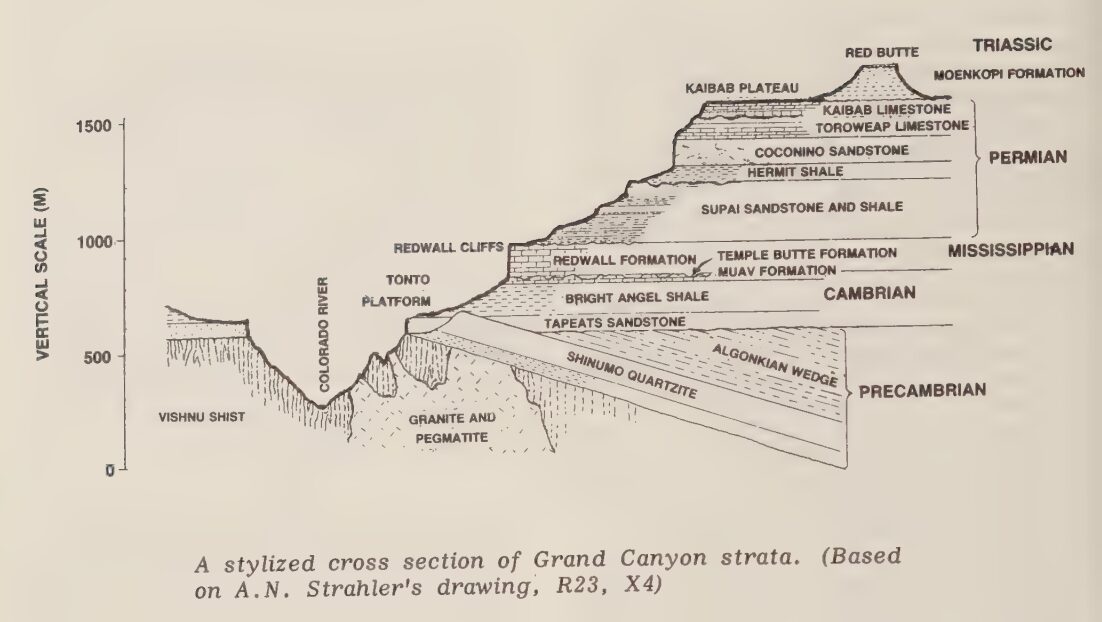
The Grand Canyon. The Grand Canyon is a Mecca for geologists. The mile-deep incision cuts down through hundreds of millions of years of strata. Hiking down the trail to the bottom, one passes back through time, age after geological age. Most sedimentary beds are laid down neatly and horizontally. However, about half way down to the Colorado River, one encounters the following sign:
AN UNCONFORMITY
Rocks of Ordovician and Silurian Periods are missing in Grand Canyon. Temple Butte Limestone of Devonian age occurs in scattered pockets. Redwall Limestone rests on these Devonian rocks or on Muav Limestone of much earlier Cambrian Age.
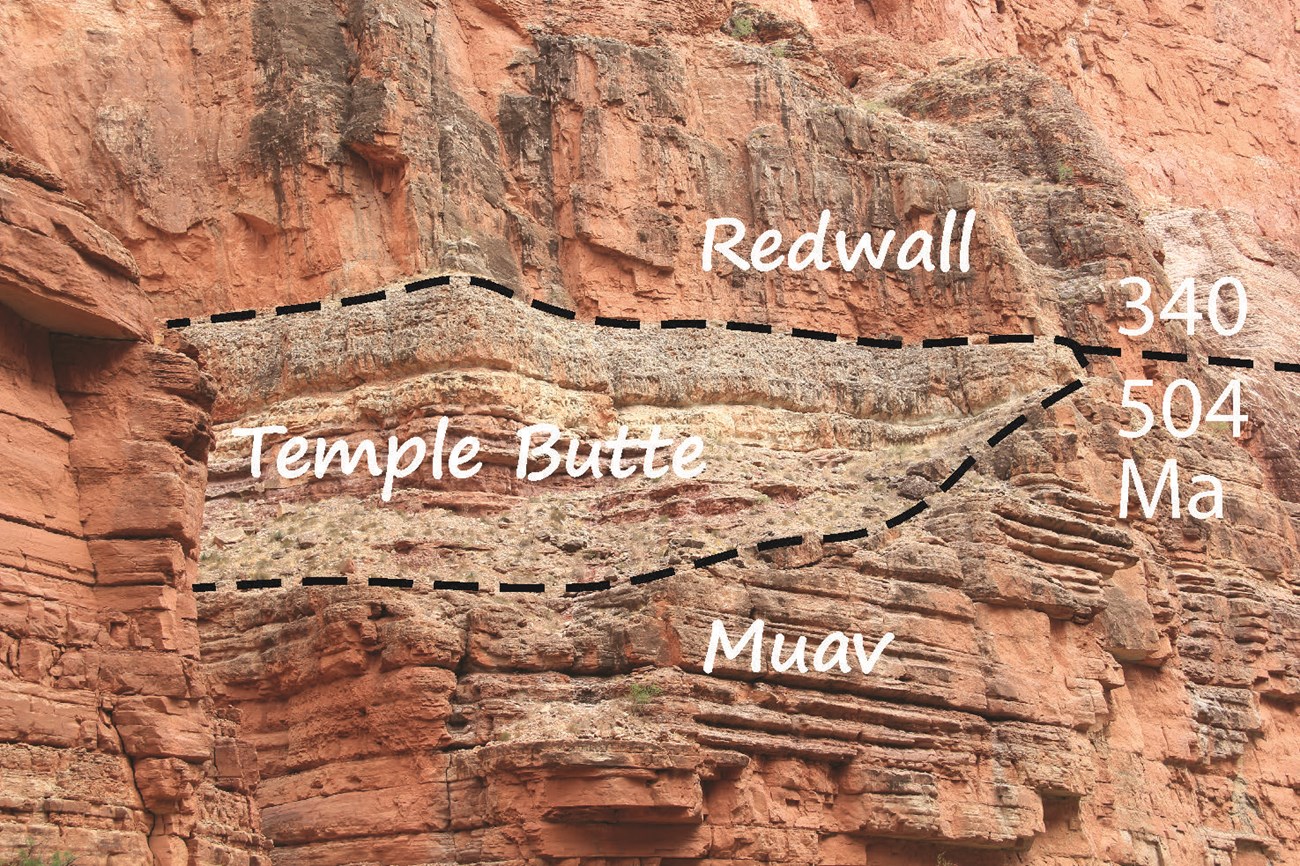
Over 200 million years of sediment are missing at this spot, which is indicated on the accompanying sketch. Another 20 million years are absent higher up. C. Burdick described both hiatuses in more detail in the following paragraphs.
The Supai formation apparently lies conformably upon the Redwall, 550 feet of Mississippian limestone. [See sketch] By conformably I mean that no apparent angular discordance exists between the two formations that might suggest a time interval between the periods of deposition. However, we are told that such a gap exists, a gap of perhaps some 20,000,000 years of Pennsylvanian time, so deducted because of the lack or non-existence of Pennsylvanian fossils. As one descends deeper into the gash in the earth, he passes 550 feet of Redwall Mississippian limestone dyed red by the overlying red Supai formation. This formation lies apparently conformably upon the Cambrian Mauve [sic] limestone. By conformably we mean that the two formations lie one upon the other like leaves in a book, with no apparent angular discordance due to tilting of the strata and subsequent erosion, which one would expect if a time gap between episodes of [deposition] had taken place. The Ordovician, Silurian and Lower Devonian are missing at this place in the Canyon, in fact the first two are missing over most of Arizona. Let us contemplate the significance of such an awesome hiatus, of some 100,000,000 years. In our own lifetime we can measure the rise of certain shorelines and the sinking of others. Twenhofel remarked that there is hardly a place on earth that is really stable.” Most geologists assign 200,000,000+ years to this gap.
Mainstream geologists do not deny these gaps. Here, we add some remarks by A.N. Strahler with respect to this gap.
In this case, the disconformity represents an enormous time gap. Between the Cambrian and Mississippian periods lie the Ordovician, Silurian, and Devonian periods, which total about 245 My. It seems hard to imagine, but the parallelism between strata above and below the disconformity requires us to conclude that throughout that vast span of time the earth’s crust in this region was not subjected to tectonic activity that elsewhere repeatedly deformed crustal rock by faulting and folding. We can only conclude that this region was part of a stable continental margin, far from any subduction boundaries where collision activity might occur and from areas of the continental lithosphere where rifting was in progress.
But is such a conclusion reasonable? It has to be considered so if our view of the development of the earth and its biological cargo is to remain intact.

The Colorado Plateau. An extensive unconformity separates the Permian and Triassic ages on the Colorado Plateau, as well as at many other locations on our planet. This 245-million-year-old unconformity “apparently” does not mark the omission of a great thickness of strata (and the time it took to deposit it), rather it was a major turning point in the history of life. The Permian-Triassic transition is marked by mass extinctions; viz., the trilobites. It was in the words of S.J. Gould “a time of great dying”. After the massive extinctions, the geological clock moved to the Triassic, and life reflowered. But, something of great importance happened on the earth at this juncture; and we do not know what it was and how long it lasted. We do not know if sediments were deposited and subsequently eroded away. This Permian-Triassic boundary is, in some parts of the world, very poorly marked. Geologically, the two periods seem to blend into one another, despite what happened to the biosphere. N.D. Newell has remarked on this fauna-delineated boundary as it appears on the Colorado Plateau.
“Physical evidence of an unconformity by at the era boundaries may be obscure or equivocal at some localities. For example, the Permo-Triassic rocks are approximately parallel over an area of hundreds of thousands of square miles on the Colorado Plateau (Kaibab-Moen-kopi formations) and in the northern Rocky Mountains (Phosphoria-Woodside). At many outcrops the contact between the two systems is structurely concordant and apparently conformable. Regional studies, however, show that unconformity separates the Permian Triassic rocks probably throughout of this region.”
The Salt Range, Pakistan. A situation analogous to that just described for the Colorado Plateau prevails in Pakistan’s Salt Range. Despite the striking faunal changes across the Permo-Triassic boundary, numerous investigators confirm: “that there is no evident physical break between the Permian and Triassic rocks in the Salt Range.”
Two important Canadian paraconformities. The two examples below cited by G.M. Price are supported by quotations from reports of the Canadian Geological Survey.
Near Banff, Alberta:
“East of the main divide the Lower Carboniferous is overlaid in places by beds of Lower Cretaceous age; and here again, although the two formations differ so widely in respect to age, one overlies the other without any perceptible break, and the separation of one from the other is rendered more difficult by the fact that the upper beds of the Carboniferous are lithologically almost precisely like those of the Cretaceous [above them]. Were it not for fossil evidence, one would naturally suppose that a single formation was being dealt with.”
- Reference: Canadian “Annual Report”, Geological Survey, New Series, 2, Part A, 8.
Near Lake Athabaska, Alberta and Saskatchewan:
“There is a large area near Lake Athabaska, Canada, where a Devonian limestone is conformably covered Cretaceous beds. The ‘remarkable persistence’ of this ‘deceptive’ conformity, according to an officer of the Canadian Geological Survey, extends in one direction for fully 150 miles; and yet, over this wide area, according to this very competent authority, ‘the vast interval of time which separated the two formations is, so far as observed, unrepresented either by deposition or erosion.’ Indeed, this same succession of strata, Cretaceous upon Devonian, extends nearly to Lake Manitoba, some 500 miles away, though it would be quite unreasonable honest to expect conformity even to extend the most to any such distance.”
The source given by Price for the example is also the Anual Report of the Canadian Geological Survey, New Series, Vol. 5, Part D, p. 52.
The situation in the above two examples resembles that at the Permo-Triassic boundary, as sketched in X5 and X6, except that here there are definitely large blocks of missing time, according to current geological thinking.
Indian Ocean sediments. Until the 1970s, oceanographers believed that sedimentation in the oceans was essentially continuous. But cores recovered during the Deep Sea Drilling Project (DSDP) revealed missing sediments in virtually all of the oceans. The Indian Ocean, in particular, is noted for its many sedimentary gaps as in the following quotation.
“Sediments spanning ‘vast intervals of geologic time’ – as much as 50 million years – are completely missing from many areas of the Indian Ocean. In seven of the eight deepest holes, there was a gap in the sediments between 40 million and 20 million years old. A gap of about the same age and duration had been found by Leg 21 scientists off the east coast of Australia.”
Later drilling in the Indian Ocean demonstrated that there were many gaps and that some were ocean-wide in extent. They were concentrated in the Oligocene, early Tertiary, and late Cretaceous periods. The authors thought the gaps to be best explained by appealing to climatic events in Antarctica, which subsequently altered the circulation patterns of the Indian Ocean.
The situation may be no better in the other oceans. Drilling in the South Atlantic has found barely half of the sedimentary record expected for the past 125 million years.
The incompleteness of the Stratigraphic Record: The Sedimentation Rate argument. Up until now, we have concentrated on specific unconformities, paraconformities, and their implied gaps. There is, though, a convincing type of argument that leads to the conclusion that the Stratigraphic Record we chip away at with our geology hammers actually represents only a few percent of the total span of geological time.
This approach involves estimating the amount of time required for the deposition of specific strata by applying the deposition rates measured at appropriate present-day sites. T.H. van Andel has expounded eloquently upon this subject.
“For years I have been intrigued by the result of such estimates. In Wyoming, a sequence of early Cretaceous sandstones and shales closely resembles the coastal sediments of the present Gulf of Mexico. Applying the appropriate rates of deposition we find that a mere 100,000 years would suffice to produce the entire sequence. Yet the stratigraphical interval occupied by the deposits is quite firmly known to encompass about 6 million years. We may repeat the experiment elsewhere; invariably we find that the rock record requires only a small fraction, usually 1 to 10 per cent, of the available time, even if we take account of all possible breaks in the sequence.”
Further applications of modern sedimentation rates to ancient strata led van Andel to these conclusions:
“Thus it appears that indeed the geological record is exceedingly incomplete, and that the incompleteness is greater the shorter the time span at which we look….The geological record may thus be a record of rare events separated on any time scale by numerous and long gaps.”
A.N. Strahler has adopted a more uniformitarian scenario to fill up the admitted great gaps implied by the sedimentation-rate argument. Strahler believes that the time gaps are filled by innumerable brief cessations of sedimentation, perhaps only a few years or a century or two long. In geology these tiny hiatuses are called “diastems”.
Spans of geological time are now measured by radiometric methods, rather than sedimentation rates. One cannot compress geological time without overthrowing the tenets of radiometric chronology. Further, one must ask what, if anything, happened during the 90% or so of geological time for which we have no record.
The incompleteness of the Stratiraphic Record: The Missing Period argument. The sedimentation-rate argument tells only part of the “gap” story – the part concerned with vanished or undeposited volumes of sediments. In addition to the attributes of thickness, each stratum also possesses the properties of geographical extent and fossil content. It is the latter property, of course, that allows us to assign each stratum to a geological period, such as the Permian or Cretaceous. Absolute dates are assigned radiometrically. When the earth’s geological formations are mapped globally, by geological period, an astounding patchwork appears. It is a patchwork with more holes than fabric! The various geological periods comprising the classical Stratigraphic Record are distributed spottily and sparingly on world maps. Indeed, there is virtually no place on earth where all periods are represented.
The great bulk of the Stratigraphic Record has either been removed or was never deposited in the first place. (Complete sequences have been reported from the Bolivian Andes and Nepalese Himalayas, although there are doubts even at these locations.) It is interesting, but perhaps not surprising, that the best review of this problem was prepared by a creationist, J. Woodmorappe [a pseudonym]. Backed with 97 papers and books from the scientific literature, Woodmorappe has generated 15 maps that indicate where each major geological period has been reported as being present or not present. We have room here for only two of these maps – the Permian and Triassic. In conjunction with the maps, it is appropiate to present Woodmorappe’s abstract.
“This article is a systematic and quantitative demonstration of global distributional tendencies of the evolutionary-uniformitarian geologic column. Maps have been drawn to show the worldwide distributions of all ten geologic periods on all seven continents, and such maps have also been drafted to show complete segments of the geologic column in place. Calculations have been performed to measure successional tendencies of geologic periods over the earth. For example it has been found that two-thirds of the earth’s land surface has 5 or fewer of the 10 geologic periods in place, and only 15-20% of the earth’s land surface has even 3 geologic periods appearing in ‘correct! consecutive order. These and similar findings have been briefly related to the Creationist-Diluvalist paradigm.”
It is vital to add that Woodmorappe’s maps show only the continents. It is well-recognized that almost all of the sediments preserved in today’s oceans are very young—less than 250 million years old. Woodmorappe-type maps of the oceans prior to the Jurassic would be solid black.
A vertical profile. Woodmorappe has gone a step further in his analysis. He provides us with a table in which he notes for each period the area-percentage for which this period is in direct contact with each older period. We reproduce here the figures for the Permian period:
| Permian/ Carboniferous | 76.3 % |
| Permian / Devonian | 10.5 % |
| Permian/ Silurian | 6.08 % |
| Permian / Ordovician | 1.10 % |
| Permian/ Cambrian | 2.76 % |
| Permian/ Precambrian | 3.30 % |
Obviously, most of the Permian strata lie directly on the Carboniferous, as they should—but not always. In fact, the table confirms what G.M. Price maintained earlier in this section: missing strata are common in the Stratigraphic Record, and a younger period’s strata may be found on the strata of any older period. Of course, Woodmorappe’s table does not show the percentages of the contacts that are conformable and unconformable. It is also obvious that Woodmorappe’s maps will change as geological mapping proceeds.
What does it all mean? Woodmorappe, being a scientific creationist, takes the position that his results call into question the very existence of geological periods and expose, as well, the fiction of a complete Stratigraphic Record, with its time-wise orderly development of life. The Stratigraphic Record is, he says, only an artificial construct dessigned to support the evolutionary-uniformitarian paradigm.
Such sweeping conclusions are anathema to the scientific community. But, one must admit that Woodmorappe’s research does engender questions: Could Cretaceous sediments have been laid down some place on the globe, while Tertiary sediments were accumulating elsewhere – at the same time? Radiometric dating can, in principle, answer such questions; but has it done this in a convincing number of cases? Do the black areas on Woodmorappe’s maps, representing absent sediments, indicate erosion or lack of deposition? Woodmorappe makes the statement that in the tens of millions of years allowed each geological period some sediments should have accumulated in each.
If so, could erosion have swept whole continents clean? And where did all these sediments go? Mainstream science believes that its armory of fossil succession, radiometric dating, and episodic erosion and sedimentation, caused by changing sea levels and the rising and subsiding of land are more than sufficent. It is a matter of opinion whether these accepted processes can cope with the sheer number and magnitudes of the gaps in the Stratigraphic Record. In the compiler’s view, the gaps are so large – time-wise, volume-wise, and area-wise – that these mainstream paradigms must be reconsidered.
References
- R1. Bigsby, J.J.; “On Missing Sedimentary Formations, from Suspension or Removal of Deposits,” Geological Society of London, Quarterly Journal, 20:198, 1864. (X2, X10)
- R2. Kindle, Edward M.; “The Unconformity at the Base of the Chattanooga Shale in Kentucky,” American Journal of Science, 4:33:120, 1912. (X3)
- R3. Price, George McCready; “Finding Bottom: Fact Number One,” Evolutionary Geology and the New Catastrophism, Mountain View, 1926, pp. 73 and 92. (X2, X10)
- R4. Price, George McCready; “The Fossils and the Flood,” Catholic World, 138:297, 1933. (X2)
- R5. Hares, C.J.; “Arlington Unconformity,” Geological Society of America, Bulletin, 49:1884, 1938. (X5)
- R6. Kelly, Allan O., and Dachille, Frank; “The Waters that Mould the Earth,” Target: Earth, Carlsbad, 1953, p. 140. (X4)
- R7. Newell, Norman D.; “Catastrophism and the Fossil Record,” Evolution, 10:97, 1956. (X5, X6)
- R8. Burdick, Clifford; “The Grand Canyon Story,” in The Challenge of Creation, Walter Lang, ed., Caldwell, 1965, p. 31. (X4)
- R9. Nelson, Byron C.; “Modern Geology: The Deluge Story in Stone, Minneapolis, 1968, p. 137. (X1)
- R10. Price, George McCready; “Some Early Experiences with Evolutionary Geology” Report on Evolution, Malverne, 1971. (X7)
- R11. “Some Surprises from under the Indian Ocean,” Science News, 102: 212, 1972. (X8)
- R12. Ager, Derek V.; “More Gaps than Record,” The Nature of the Stratigraphical Record, London, 1973, p. 27. (X0)
- R13. Daly, Reginald; “Devices for Reconciling Inconsistencies,” Earth’s Most Challenging Mysteries, Nutley, 1975, p. 88. (X2, X6)
- R14. Davies, Thomas A., et al; “Unconformities in the Sediments of the Indian Ocean,” Nature, 253:15, 1975. (X8)
- R15. Glikson, A.Y.; “The Missing Precambrian Crust,” Geology, 7:449, 1979. (X1)
- R16. Baer, Alec J., and Glikson, A.Y.; “Comment and Reply on ‘The Missing Precambrian Crust’,” Geology, 8:114, 1980. (X1)
- R17. Carey, S. Warren; “The Necessity for Earth Expansion,” in The Expanding Earth: A Symposium, S. Warren Carey, ed., University of Tasmania, 1981, p. 375. (X1)
- R18. van Andel, Tjeerd H.; “Consider the Incompleteness of the Geological Record,” Nature, 294:397, 1981. (X8, X9)
- R19. Woodmorappe, John; “The Essential Nonexistence of the Evolutionary-Uniformitarian Geologic Column: A Quantitative Assessment,” Creation Research Society Quarterly, 18: 46, 1981. (X10)
- R20. Mehlert, A.W.; “Diluviology and Uniformitarian Geology: A Review,” Creation Research Society Quarterly, 23:104, 1986. (X0, X4)
- R21. Moores, E.M.; “The Proterozoic-Ophiolite Problem, Continental Emergence, and the Venus Connection,” Science, 234:65, 1986. (X1)
- R22. Waisgerber, William, et al; “Mississippian and Cambrian Interbedding: 200 Million Years Hiatus in Question,” Creation Research Society Quarterly, 23:160, 1987. (X4)
- R23. Strahler, Arthur N.; “Stratigraphy and the Fossil Record,” Scientific and Earth History, Buffalo, 1987, p. 297. (X0, X3, X4, X9)
- R24. Carey, S. Warren; “The Earth Is Expanding,” Theories of the Earth and Universe, Stanford, 1988, p. 164. (X1)


